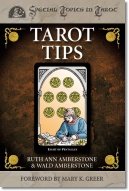|
Tarot Reflections |
|
December 15, 2003 |
|
Book Review: Tarot Tips Robert E. Mueller, CPTR |
||||||
|
The history of this book begins when Ruth Ann started the New York school's free e-mail newsletter, Tarot Tips, in the fall of 1998. Created initially for their students, the newsletter soon had a worldwide following. As Ruth Ann writes in the Introduction, it grew "one small piece at a time, like a coral reef." These little "coral" tips, gathered together from the questions of students of all Tarot reading levels, comprise the contents of their book. With their division into chapters, you can easily find the area in which you are most interested. Then, without even needing a wet suit and diving tank, you can jump right in and get your questions answered by these famous Tarot experts and teachers. My own curiosity lead me to start with Tip #34, Ten Practical Questions To Ask the Tarot. For the newcomer, here is a valuable list of questions you can use to practice and hone your reading skills with friends and neighbors. You can type up this list and present to clients who haven't an idea about the Tarot, or who don't know where to start. This set of practice questions will prepare you for those long reading lines you will encounter when you read at a party and when you go professional. One of the most common questions you will ever get as a reader is the yes/no question. Aside from the obvious solution of rephrasing the question, Tip #55 offers you four variations on a theme, i.e., choices from the simple to the complex for handling yes/no questions. The authors indicate that they learned these variations from Gina Pace. It is especially pleasing that they credit their teacher colleague—a level of ethics that is not found in a lot of Tarot books. Predicting the timing of an outcome is another common question. Although I personally stay away from predicting timed outcomes, Tip #42, Timing in a Reading, can be helpful for those inclined to venture into this particular realm of predictive readings. The authors write, "Predictive readings can be tricky, and many Tarot readers are reluctant to do them, but I'm going out on a limb here and tell you that I believe they have a place." Then the Amberstones explain how you might use the numbers on the cards, and the four Minor Arcana suits as times of day, seasons of the year, and as reflecting specific timing (days, weeks, months, a year or more). Choices, choices, choices. Tip #57, the Double-Edged Sword Spread, offers a spread that allows clients to make their own evaluations and choose their own outcome. The name comes from the spread's shape of an upright sword with two edges and because it "utilizes the energy of the suit of Swords to help bring clarity and discrimination to difficult decisions." It is particularly useful for choices such as those involving relationships, jobs, moving, and careers. Although the layout is simple, the interpretation is subtle and may take some practice, especially since the cards have no specific positions. Not to worry. Tip #56, Reading Spreads Without Assigned Positions, will help you there. Those pesky court cards trouble a lot of Tarot readers. Tip #24 reminds us that a court card can be "operating on more than one level at the same time." For instance, court cards can be used for timing by attending to their astrological attribution. They also can be understood as presenting a specific energetic quality, that the Amberstones call "pace, e.g. instantaneous, rapid, slow, or stationary (cards in the suits of Wands, Swords, Cups, and Pentacles, respectively)." For me, the rank of each court card as giving a clue to maturity is one I appreciate and use frequently, but, wait! I can't be satisfied because there are still more ways to understand them. According to the Amberstones, you can understand the court cards in terms of masculine and feminine qualities, regardless of the sex of the querent. Finally, the combination of the suit element and the specific elements assigned to each court card also allows you to consider how that might apply to, or affect, querents or the situations in which they find themselves. I'm glad we've resolved that, but there's no time to relax yet. What do you do when you see two or more cards that seem to have nothing to do with the question? Oh, my, don't we all know about that! Tip #49, Contradictory Cards, explores cards' hidden attributes and some ways to view seemingly contradictory cards from a different perspective. If you think you're ready to become a professional reader, insights into what it takes to be a pro are contained in detail in Tip #77. In this review I have only been able to skim the surface of the book, but it is clearly a book for all levels of readers. If you can't find something in this book that can help you become a better Tarot reader, you're either dead or if you must "play with cards," you need to consider a dealer's job in Las Vegas. I especially recommend it because of its insights, knowledgeable comments, and the obvious wealth of shared Tarot experience. |
|||||
|
|
||||||
|
Subscribe to Tarot Reflections, and receive notification of each update! |
|
Request to be added to the list by sending email to TarotReflections-subscribe@yahoogroups.com! |
All articles remain the
property of their respective authors.
Tarot Reflections is a publication of the American Tarot Association
- Copyright (C) 2003
Questions or Comments? Contact Us.


